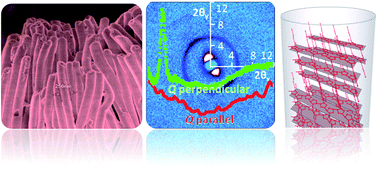Poly(3-hexylthiophene) nanowires in porous alumina: internal structure under confinement†
Abstract
We study the structure of poly(3-hexylthiophene) (P3HT) subjected to nanoscale confinement in two dimensions (2D) as imposed by the rigid walls of nanopore anodic aluminum oxide (AAO) templates. P3HT nanowires with aspect ratios (length-to-diameter) above 1000 and diameters ranging between 15 nm and 350 nm are produced in the pores of the AAO templates via two processing routes. These are, namely, drying a solution or cooling from the melt. Our study focuses on the effects of nanoconfinement on the semicrystalline nature of the nanowires, the orientation of crystals, and the evolution of the structures that P3HT might develop under confinement, which we investigate by combining imaging (SEM), spectroscopic (FTIR, photoluminescence) and structural characterization (WAXS, DSC) techniques. Solution-processed P3HT nanowires are essentially amorphous and porous, whereas melt-processed nanowires are semicrystalline, and present a more compact morphology and smoother surfaces. In the latter case, the orientation of crystals was found to strongly depend on the pore diameter. In large diameter nanowires (250 nm and 120 nm), crystals are oriented laying the π–π stacking direction parallel to the nanowire axis. In contrast, in small diameter nanowires, the π–π stacking direction is mainly perpendicular to the nanowires, as crystals are likely to nucleate at pore walls. The structural evolution of P3HT upon heating into weakly (250 nm in diameter) and strongly (15 nm in diameter) confining pores has been studied. A complex set of structures is observed, i.e., crystals, a solid layered mesophase, a nematic/smectic mesophase, and the isotropic melt. Interestingly, a rare crystal polymorph (form II) is also observed under strong confinement conditions together with the usual lamellar crystal form I. Furthermore, we show that nanoconfinement stabilizes form II: such crystals are still present at 210 °C while in the bulk they get converted to form I crystals at around 50 °C.


 Please wait while we load your content...
Please wait while we load your content...